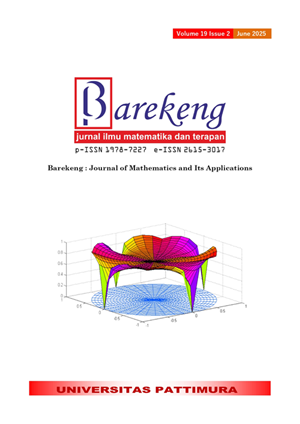POSITIVE CONFIRMED PREDICTION OF COVID-19 IN EAST JAVA USING COUNT TIME SERIES BASED DOUBLE POISSON INAR(p) PROCESS
Abstract
In December 2019, there was a virus outbreak caused by a virus disease with a relatively high spread in Indonesia, one of which was in East Java Province. It is proven by the number of new cases on January 15, 2021, in East Java, reaching 12818 cases. This is why researchers predict the number of positive cases of COVID-19 in East Java so that the Government can anticipate an increase in the number of COVID-19 patients. This study uses data on the addition of positive COVID-19 cases in East Java from May 16, 2020, to January 24, 2021. Because the count time series data shows overdispersion, predictions are made by modeling the COVID-19 data using the INAR( ). development model, namely Double Poisson INAR( ). Several tests were carried out with data from the Double Poisson distribution, and then the ACF and PACF plots were analyzed to find the order of INARDP. After obtaining the order, the model can be constructed and estimated using MLE. Then, the prediction of adding COVID-19 cases in East Java on January 25, 2021, obtained 949 cases with an estimated error of 13.73 percent. So, the model show that the accuracy of the forecasted value with actual value is 86.17 percent.
Downloads
References
N. Coronavirus, “Available online: https://www. who. int/emergencies/diseases/novel-coronavirus-2019,” Accessed on, vol. 10, 2020.
P. S. Blagov, “ADAPTIVE AND DARK PERSONALITY IN THE COVID-19 PANDEMIC: PREDICTING HEALTH-BEHAVIOR ENDORSEMENT AND THE APPEAL OF PUBLIC-HEALTH MESSAGES,” Soc Psychol Personal Sci, vol. 12, no. 5, pp. 697–707, 2021.
C. H. Weiß, “A POISSON INAR (1) MODEL WITH SERIALLY DEPENDENT INNOVATIONS,” Metrika, vol. 78, no. 7, pp. 829–851, 2015.
D. C. Montgomery, C. L. Jennings, and M. Kulahci, INTRODUCTION TO TIME SERIES ANALYSIS AND FORECASTING. John Wiley & Sons, 2015.
W. W. S. Wei, “TIME SERIES ANALYSIS: UNIVARIATE AND MULTIVARIATE,” Methods. Boston, MA: Pearson Addison Wesley, 2006.
R. Wardrop, “REGRESSION MODELS FOR COUNT DATA BASED ON THE DOUBLE POISSON DISTRIBUTION,” 2016.
B. Efron, “DOUBLE EXPONENTIAL FAMILIES AND THEIR USE IN GENERALIZED LINEAR REGRESSION,” J Am Stat Assoc, vol. 81, no. 395, pp. 709–721, 1986.
A. C. Cameron and P. Johansson, “COUNT DATA REGRESSION USING SERIES EXPANSIONS: WITH APPLICATIONS,” Journal of Applied Econometrics, vol. 12, no. 3, pp. 203–223, 1997.
Y. Zou, S. R. Geedipally, and D. Lord, “EVALUATING THE DOUBLE POISSON GENERALIZED LINEAR MODEL,” Accid Anal Prev, vol. 59, pp. 497–505, 2013.
R. Fitriani and I. G. N. M. Jaya, “SPATIAL MODELING OF CONFIRMED COVID-19 PANDEMIC IN EAST JAVA PROVINCE BY GEOGRAPHICALLY WEIGHTED NEGATIVE BINOMIAL REGRESSION,” Communications in Mathematical Biology and Neuroscience, vol. 2020, pp. 1–17, 2020.
M. Bourguignon, J. Rodrigues, and M. Santos-Neto, “EXTENDED POISSON INAR (1) PROCESSES WITH EQUIDISPERSION, UNDERDISPERSION AND OVERDISPERSION,” J Appl Stat, vol. 46, no. 1, pp. 101–118, 2019.
F. W. Steutel and K. van Harn, “DISCRETE ANALOGUES OF SELF-DECOMPOSABILITY AND STABILITY,” The Annals of Probability, pp. 893–899, 1979.
K. Van Harn, “CLASSIFYING INFINITELY DIVISIBLE DISTRIBUTIONS BY FUNCTIONAL EQUATIONS,” 1978.
G. S. Osho, “A GENERAL FRAMEWORK FOR TIME SERIES FORECASTING MODEL USING AUTOREGRESSIVE INTEGRATED MOVING AVERAGE-ARIMA AND TRANSFER FUNCTIONS,” Int J Stat Probab, vol. 8, no. 6, pp. 1–23, 2019.
K. F. Pinontoan, “PEMODELAN SINGLE EXPONENTIAL SMOOTHING (SES) DAN INTEGER AUTOREGRESSIVE (INAR) PADA PERAMALAN PERMINTAAN INTERMITTENT,” FRONTIERS: JURNAL SAINS DAN TEKNOLOGI, vol. 1, no. 2, 2018.
R. Bu and B. McCabe, “MODEL SELECTION, ESTIMATION AND FORECASTING IN INAR (P) MODELS: A LIKELIHOOD-BASED MARKOV CHAIN APPROACH,” Int J Forecast, vol. 24, no. 1, pp. 151–162, 2008.
X. Pedeli, A. C. Davison, and K. Fokianos, “LIKELIHOOD ESTIMATION FOR THE INAR (P) MODEL BY SADDLEPOINT APPROXIMATION,” J Am Stat Assoc, vol. 110, no. 511, pp. 1229–1238, 2015.
F. Zhu, “MODELING OVERDISPERSED OR UNDERDISPERSED COUNT DATA WITH GENERALIZED POISSON INTEGER-VALUED GARCH MODELS,” J Math Anal Appl, vol. 389, no. 1, pp. 58–71, 2012.
N. Silva, I. Pereira, and M. E. Silva, “FORECASTING IN INAR (1) MODEL,” REVSTAT-Statistical Journal, vol. 7, no. 1, pp. 119–134, 2009.
F. C. Drost, R. Van den Akker, and B. J. M. Werker, “EFFICIENT ESTIMATION OF AUTO-REGRESSION PARAMETERS AND INNOVATION DISTRIBUTIONS FOR SEMIPARAMETRIC INTEGER-VALUED AR (p) MODELS,” J R Stat Soc Series B Stat Methodol, vol. 71, no. 2, pp. 467–485, 2009.
S. Zhang, M. Diao, W. Yu, L. Pei, Z. Lin, and D. Chen, “ESTIMATION OF THE REPRODUCTIVE NUMBER OF NOVEL CORONAVIRUS (COVID-19) AND THE PROBABLE OUTBREAK SIZE ON THE DIAMOND PRINCESS CRUISE SHIP: A DATA-DRIVEN ANALYSIS,” International journal of infectious diseases, vol. 93, pp. 201–204, 2020.
M. S. A. Abotaleb, “PREDICTING COVID-19 CASES USING SOME STATISTICAL MODELS: AN APPLICATION TO THE CASES REPORTED IN CHINA ITALY AND USA,” Academic Journal of Applied Mathematical Sciences, vol. 6, no. 4, pp. 32–40, 2020.
D. Fanelli and F. Piazza, “ANALYSIS AND FORECAST OF COVID-19 SPREADING IN CHINA, ITALY AND FRANCE,” Chaos Solitons Fractals, vol. 134, p. 109761, 2020.
Copyright (c) 2025 A'yunin Sofro, Framitha Septian Subiantoro, Khusnia Nurul Khikmah

This work is licensed under a Creative Commons Attribution-ShareAlike 4.0 International License.
Authors who publish with this Journal agree to the following terms:
- Author retain copyright and grant the journal right of first publication with the work simultaneously licensed under a creative commons attribution license that allow others to share the work within an acknowledgement of the work’s authorship and initial publication of this journal.
- Authors are able to enter into separate, additional contractual arrangement for the non-exclusive distribution of the journal’s published version of the work (e.g. acknowledgement of its initial publication in this journal).
- Authors are permitted and encouraged to post their work online (e.g. in institutional repositories or on their websites) prior to and during the submission process, as it can lead to productive exchanges, as well as earlier and greater citation of published works.






1.gif)



